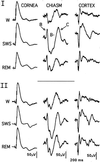Sleep modifies retinal ganglion cell responses in the normal rat
- PMID: 11172079
- PMCID: PMC29385
- DOI: 10.1073/pnas.98.4.2083
Sleep modifies retinal ganglion cell responses in the normal rat
Abstract
Recordings were obtained from the visual system of rats as they cycled normally between waking (W), slow-wave sleep (SWS), and rapid eye movement (REM) sleep. Responses to flashes delivered by a light-emitting diode attached permanently to the skull were recorded through electrodes implanted on the cornea, in the chiasm, and on the cortex. The chiasm response reveals the temporal order in which the activated ganglion cell population exits the eyeball; as reported, this triphasic event is invariably short in latency (5--10 ms) and around 300 ms in duration, called the histogram. Here we describe the differences in the histograms recorded during W, SWS, and REM. SWS histograms are always larger than W histograms, and an REM histogram can resemble either. In other words, the optic nerve response to a given stimulus is labile; its configuration depends on whether the rat is asleep or awake. We link this physiological information with the anatomical fact that the brain dorsal raphe region, which is known to have a sleep regulatory role, sends fibers to the rat retina and receives fibers from it. At the cortical electrode, the visual cortical response amplitudes also vary, being largest during SWS. This well known phenomenon often is explained by changes taking place at the thalamic level. However, in the rat, the labile cortical response covaries with the labile optic nerve response, which suggests the cortical response enhancement during SWS is determined more by what happens in the retina than by what happens in the thalamus.
Figures





References
Publication types
MeSH terms
LinkOut - more resources
Full Text Sources

